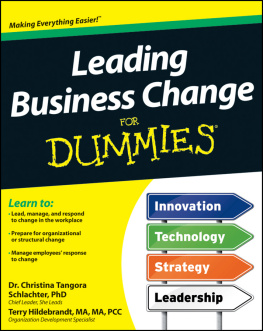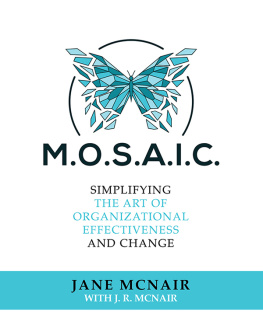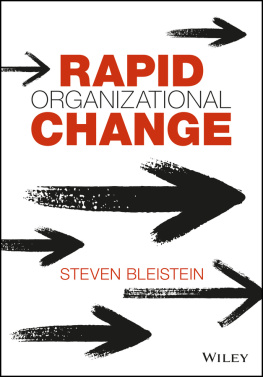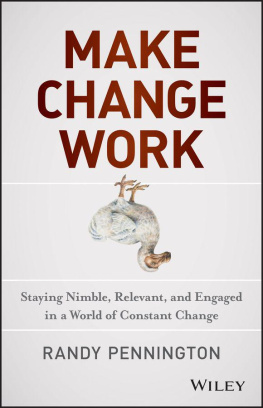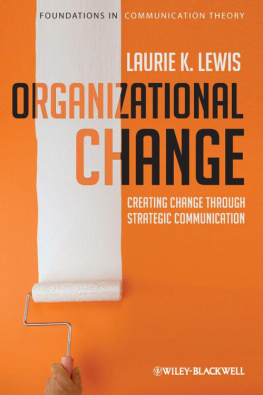]>
]>
Copyright 2020 Pam Marmon
All rights reserved.
ISBN: 978-1-5445-0709-5
]>
To my darlings, John Henry, Gabriel, and Dominickyou set my world on fire.
To my beloved husband, Samyou hold the flame.
]>
Contents
]>
Introduction
The Point of No Return
Imagine the moment when everyone in your company finds out your secret. Youve spent months quietly developing an initiative that will transform your organization. You are getting ready for the grand unveiling, but now people have gotten wind that you are working on a change effort. Your diligent work behind closed doors has kindled rumors, and gossip has surfaced throughout your organization. You feel pressed against a wall. The inevitable announcement is looming, and you know it will disrupt the status quo.
The day of the announcement arrives. Your speech and presentation are polished. The stage is set and ready for the big reveal. The chairs are in perfect rows, one behind the other, empty and coldfor now.
You sift through your notes, palms sweatingyet you are confident because this is not your first time persuading a crowd. This time, however, the stakes are high. This is a message the company has been anticipating, and this message will change its future.
Will they rally behind the new vision? Will they still like you? What if they dont? Does it really matter?
You try to set these thoughts aside and go back to your notes. You reread the message. If only there was more time to rehearse it. You take in a deep breath and slowly let it out for a count of five, four, three, two, one.
People are filling the room one by one, with coffee in hand. You overhear chatter in the background. You smile, but on the inside, you are tense. The audience doesnt know youre nervous, and they never will.
You are an accomplished leader, vested in their successand yours. You care deeply about your companys future. You care deeply about your people. Well there are probably a few of them you would rather redirect. You shrug and focus back on your notes.
Now the auditorium is full and the time has arrived. The microphone is turned on. You hear your footsteps as you walk up to the podium. You shuffle your papers. The bright lights blind you for a moment. The audiences gaze is fixed on you. You clear your throat. Ahem.
There is absolute silence. You smile, and then you begin to speak. Your voice echoes through the room; the words flow out of your mouth and there is no snatching them back. This is the point of no return.
You hear a gasp. Someone claps. And then more silence. You hear some unexpected murmurs that surprise you.
And then it is over. Lights go out. The crowd shuffles out. You are once again alone, thinking about your message, the message you have cradled for months in preparation for this very day.
You take another deep breath. Now what?
Does this incident sound familiar? Could this be your story that unfolded on the pages you just read? Perhaps it takes you back to a moment in time when you had to deliver a message that would transform your organization. Was the outcome what you expected? Or was there silence?
Communicating company messages, especially messages of change, has its challenges. Do you think the majority of your employees could recite your organizations mission statement? A mission statement is the most critical communication artifact that defines the purpose and the path to achieve the organizational vision, and it has the power to motivate, inspire, engage, and propel employees into action. Communicating company messages, especially messages of change, can threaten the status quo. What can be expected of layered organizational messages like the one you delivered on that podium, messages that support the mission statement? Do they stand a chance of being recognized, let alone remembered?
Stuck and Frustrated
If you are a leader of an organization, it is likely that your grand vision and fast-paced approach to transformation can leave people frustrated and struggling to keep up. You commit to goals that require your teams to streamline processes and optimize the use of systems and technology. This shift demands that your people work differently.
Your messages sound relevant, but you question if anyone is listening. You drive for results, but you have created a whirlwind of change saturation. Your people are fatigued; they are exhausted, and some doubt you. Their silence explains their lack of action. They are on the verge of quitting, and you feel frustrated. The weight of pulling your team would be lighter if only people would hear your message and execute your vision!
The One Thing You Will Learn
This book is about one thing: with the proper process, change is not hard. I will teach you how to apply systematic change communication principles to lead transformations within your organization in order to achieve desired results and grow your impact.
The content of this book will help you understand:
Why others cant keep up with your pace
How to stage changes for fluid execution that delivers results
How you can approach the change process differently to unleash the powerful force of others
How to lead transformations through relevant and timely messages that promote lasting change
We will explore how the acronym LESS (listen, empower, speak, solve) will help you right-size and enhance your communication efforts as they relate to leading organizational change. By doing less of certain activities, you will benefit from more employee engagement, participation, support, and greater interest in transformation.
Benefits to Managed Change
According to research conducted by Prosci, a prominent change management research company, projects with excellent change management programs are six times more likely to achieve project objectives than those with poor change management programs.
Intentionally managing your organizational changes will enable you to accomplish the following:
Increase the probability of success
Manage employee resistance
Minimize the impact of productivity loss
Minimize turnover of valued employees
Build change competency into the organization
Deliver project results
Enhance strong brand reputation
When you adopt the set of principles and implement the key change strategies outlined in the chapters that follow, you can help your organization grow and transform.
Your Role as a Leader of Change
When it comes to implementing changeand, specifically, communicating with your teamyour role as a leader is to speak the language of your audience. The clarity of your message will eliminate confusion and inaction. The frequency of your message will establish cadence and a drumbeat to which others can sync.
As a leader of an organization, you are responsible for operating at a strategic level within your company and perhaps at times at a tactical level as well. When it comes to leading a transformation, you must manage the timing of changes to avoid change saturation. You have to communicate the purpose of the change frequently and through multiple channels. Additionally, you have to include others in decision-making to increase ownership and shared accountability. You must engage your team appropriately, seeking and acting on feedback. You have to acknowledge peoples reactions and allow them to process the change. And, on top of all this, you must understand any resistance to the change and manage expectations, while reflecting on what is working and what needs to pivot.
Next page


